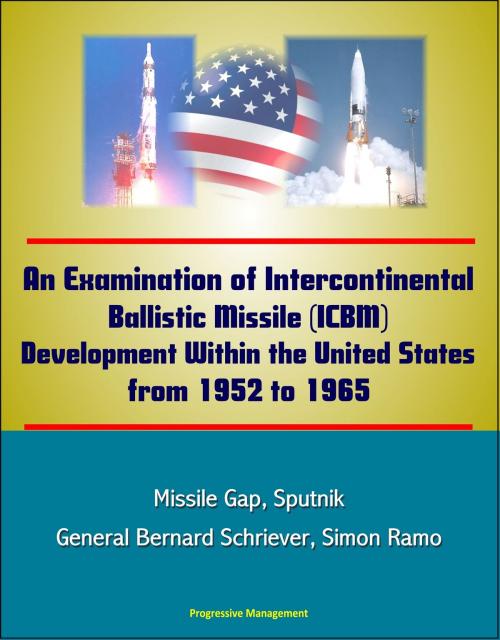An Examination of Intercontinental Ballistic Missile (ICBM) Development Within the United States from 1952 to 1965 - Missile Gap, Sputnik, General Bernard Schriever, Simon Ramo
Nonfiction, History, Military, Aviation| Author: | Progressive Management | ISBN: | 9781311928535 |
| Publisher: | Progressive Management | Publication: | May 30, 2014 |
| Imprint: | Smashwords Edition | Language: | English |
| Author: | Progressive Management |
| ISBN: | 9781311928535 |
| Publisher: | Progressive Management |
| Publication: | May 30, 2014 |
| Imprint: | Smashwords Edition |
| Language: | English |
Intercontinental ballistic missiles (ICBM) development by the United States from 1952 through 1965 was marked by extreme urgency. The initial impetus for the development did not proceed within military channels; this paper explores possible reasons why the military channels were not the originator of the program. These reasons include the competition for mission and resources an ICBM capability represented to manned strategic bombers. Significant technological breakthroughs and strong leadership from key individuals highlight the development process. The development of thermonuclear weapons helped make ICBMs possible, but no single technological breakthrough made the development of ICBMs possible. In the same way, the leadership was not generated by a single source. The leadership of General Bernard Schriever and Mr. Trevor Gardner represent a significant contribution to the journey. The management concept known as concurrency helped shorten the timelines and was teamed with a full employment of the weapon system concept and unprecedented authority within the organization responsible for the development were significant to the successful deployment. The last area examined is the revolution in military affairs produced by the mating of thermonuclear weapons and ballistic missiles as well as the deterrent policies of the administrations that provided the doctrine for this revolution.
This study examines efforts of the United States to develop and deploy intercontinental ballistic missiles (ICBM) in the years from 1952 through 1965. The specific areas addressed include background information setting the stage for the extreme urgency under which these weapon systems developed including the major committees that moved the process forward. This paper examines how this initial impetus for the development did not proceed within military channels and explores possible reasons why the military channels were not the originator of the program. In addition, this study examines the technological problems that required solutions to deploy an operational weapon system. This paper also addresses the leadership of General Bernard Schriever and Trevor Gardner as well as defining the management concept known as concurrency used to shorten the required deployment timelines. Finally, this study examines the revolution in military affairs produced by the mating of thermonuclear weapons and ballistic missiles as well as the deterrent policies of the administrations that provided the doctrine for this revolution.
ACRONYMS * CHAPTER 1 - INTRODUCTION * CHAPTER 2 - SCHRIEVER'S IMPACT * CHAPTER 3 - CONCURRENCY, COMPROMISE, AND COMPETITION WITHIN ICBM DEVELOPMENT * CHAPTER 4 - REVOLUTION IN MILITARY AFFAIRS AND THE NUCLEAR STRATEGY FOR EISENHOWER AND KENNEDY ADMINISTRATION * CHAPTER 5 - CONCLUSION
Intercontinental ballistic missiles (ICBM) development by the United States from 1952 through 1965 was marked by extreme urgency. The initial impetus for the development did not proceed within military channels; this paper explores possible reasons why the military channels were not the originator of the program. These reasons include the competition for mission and resources an ICBM capability represented to manned strategic bombers. Significant technological breakthroughs and strong leadership from key individuals highlight the development process. The development of thermonuclear weapons helped make ICBMs possible, but no single technological breakthrough made the development of ICBMs possible. In the same way, the leadership was not generated by a single source. The leadership of General Bernard Schriever and Mr. Trevor Gardner represent a significant contribution to the journey. The management concept known as concurrency helped shorten the timelines and was teamed with a full employment of the weapon system concept and unprecedented authority within the organization responsible for the development were significant to the successful deployment. The last area examined is the revolution in military affairs produced by the mating of thermonuclear weapons and ballistic missiles as well as the deterrent policies of the administrations that provided the doctrine for this revolution.
This study examines efforts of the United States to develop and deploy intercontinental ballistic missiles (ICBM) in the years from 1952 through 1965. The specific areas addressed include background information setting the stage for the extreme urgency under which these weapon systems developed including the major committees that moved the process forward. This paper examines how this initial impetus for the development did not proceed within military channels and explores possible reasons why the military channels were not the originator of the program. In addition, this study examines the technological problems that required solutions to deploy an operational weapon system. This paper also addresses the leadership of General Bernard Schriever and Trevor Gardner as well as defining the management concept known as concurrency used to shorten the required deployment timelines. Finally, this study examines the revolution in military affairs produced by the mating of thermonuclear weapons and ballistic missiles as well as the deterrent policies of the administrations that provided the doctrine for this revolution.
ACRONYMS * CHAPTER 1 - INTRODUCTION * CHAPTER 2 - SCHRIEVER'S IMPACT * CHAPTER 3 - CONCURRENCY, COMPROMISE, AND COMPETITION WITHIN ICBM DEVELOPMENT * CHAPTER 4 - REVOLUTION IN MILITARY AFFAIRS AND THE NUCLEAR STRATEGY FOR EISENHOWER AND KENNEDY ADMINISTRATION * CHAPTER 5 - CONCLUSION















